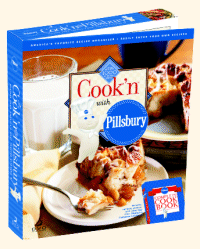
|
Never miss another recipe... Sign up for our free monthly newsletter today!
Subscribing will not result in more spam! I guarantee it! NEWSLETTER
• Current Issue• Newsletter Archive • Sign Up Now 
Cook'n with Betty Crocker 
Cook'n with Pillsbury 
Cook'n with a Taste of Home 
Cook'n in Italy 
Cook'n in Mexico |
 |
Putting It All Together |
|
Print this Recipe The body needs more than forty different nutrients for good health. How do you keep track of them all? Fortunately, someone has come up with a plan for figuring out what to eat. It’s called the Food Guide Pyramid. The Food Guide Pyramid Think of the Food Guide Pyramid as the road map for eating well. It emphasizes variety in your food choices from the five major food groups and shows you in what proportions to eat them. The Bread, Cereal, Rice and Pasta Group provides carbohydrate, iron and B vitamins (thiamin, riboflavin and niacin). Servings from this group include one ounce (about 3/4 cup) of breakfast cereal, one slice of bread, 1/2 cup cooked pasta or rice and 1/2 cup cooked cereal. Everyone needs six to eleven servings of these foods daily. The Vegetable Group is made up of—surprise—vegetables. This group provides fiber, carbohydrate, folic acid, beta-carotene and vitamin C. One cup raw leafy vegetables, 1/2 cup cooked vegetables and 3/4 cup tomato juice and some examples of servings. Eat three to five servings from this group each day. The Fruit Group supplies primarily fiber, carbohydrate, beta-carotene and vitamin C from fruit and juices. Everyone needs two to four servings of these foods each day. One medium piece of fruit, 1/2 cup of grapes or berries, 1/4 cup dried fruit (such as raisins) or 3/4 cup fruit juice are typical servings. Iron, protein, niacin, zinc, vitamin B6 and vitamin B12 (from animal sources only) come from the Meat, Poultry, Fish, Dry Beans, Eggs and Nuts Group. Two to three servings daily are enough for adults. One serving is 2 or 3 ounces of cooked lean protein (beef, poultry and fish), one egg and 2 tablespoons of peanut butter or 1/2 cup of cooked legumes (beans or peas). We should eat two to three servings from the Milk, Yogurt and Cheese Group each day. This group offers calcium, phosphorus, protein and vitamins A and D. One serving includes 1 cup of milk, 1 cup of yogurt or 1 1/2 ounces of cheese. Young adults (to age 24), pregnant women and those who are breastfeeding need three servings daily. The Fats, Oils and Sweets Group provides fatty acids and vitamin E. But avoid too much from this group, especially if you’re trying to lose weight or keep your heart healthy. By eating the recommended number of servings daily from the Food Guide Pyramid, you can ensure you will meet your needs for the many essential nutrients. Keep in mind, however, when the food groups were first devised, nutrient deficiencies were a concern. Today, we’re more likely to be getting too much of certain nutrients rather than too little. The Dietary Guidelines If you consider the Food Guide Pyramid as the “picture” of a healthy diet, then the Dietary Guidelines, developed by the Department of Health and Human Services and the United States Department of Agriculture, tell the story. There are seven Dietary Guidelines for healthy eating. Guideline #1 Eat a variety of goods. No one food contains all the nutrients you need for good health. The more different kinds of foods you eat, the better for your body. Guideline #2 Maintain a healthy weight. Keeping your weight in line reduces your chances for several diseases, including heart disease, diabetes and stroke. Eating according to the Food Guide Pyramid is a terrific start to helping control calories. Guideline #3 Choose a diet low in fat, saturated fat and cholesterol. If you do, you reduce your risk for all sorts of diseases. Limiting fat is the quickest way to keep calories in line and weight where you want it to be. Guideline #4 Choose a diet with plenty of vegetables, fruits and grain products. These foods provide the vitamins, minerals and fiber essential for good health, plus they contain certain substances, such as phytochemicals, which may significantly lower your risk for cancer and other illnesses. Guideline #5 Use sugars only in moderation. In and of itself, sugar really does not cause health problems; but in excess, sugar can contribute unnecessary calories. Too much sugar can also lead to tooth decay. Guideline #6 Use salt and sodium only in moderation. Eating too much sodium may increase your risk for high blood pressure. Some studies suggest that too much sodium may also be bad for your bones because it may increase the amount of calcium lost from your body. Guideline #7 If you drink alcoholic beverages, do so in moderation. Alcohol contains calories but not much else. Some studies have indicated it may be good for your heart. Recommendations are for moderation (not more than one or two drinks per day). As you make your food choices, consider how much fat and cholesterol they have. Also, think about their fiber, vitamin and mineral contents. Every choice does not have to be a perfect choice; some of your favorite foods may be big on taste and low on nutrition. Overall, make the foods you choose ones that will contribute positively toward your health. Find Out About Your Food As life continues to quicken in pace and fewer people take time to prepare foods from scratch, reading and understanding the information manufacturers provide about the nutritional content of their products becomes increasingly important. Once you learn how to read labels, you can make smart food choices. From "Betty Crocker's Low-Fat, Low-Cholesterol Cooking Today." Text Copyright 2005 General Mills, Inc. Used with permission of the publisher, Wiley Publishing, Inc. All Rights Reserved. This recipe comes from the Cook'n collection. Try Cook'n for FREE! Here’s to your health Fat Facts Understanding Cholesterol Other Important Nutrients Putting It All Together Reading a Nutrition Label Go Slow For Success Test Your Health IQ The Skinny on Fat Cholesterol Trimming Tips Nutritional Comparison |
|
|
Affiliate Program | Privacy Policy | Other Resources | Contact Us
© 2008 DVO Enterprises, Inc. All rights reserved. Sales: 1-888-462-6656 |

